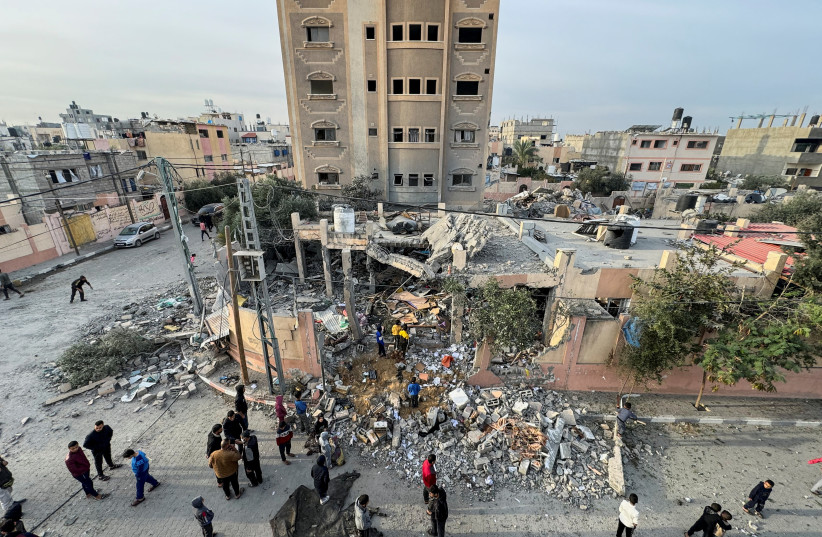Israel will not tolerate Houthi attacks on Eilat, Gallant says at sea
Defense Minister Yoav Gallant on Wednesday got closer to the Houthis than usual on a naval vessel near Eilat threatening the Yemen terror group if they dare to continue to try to attack Israel’s southernmost city.
“We will not tolerate threats and attempts to harm Eilat, the navy and the air force are ready for any order,” he said standing on the IDF navy Sa’ar 6 Magen vessel which is part of the area’s defense.
The Houthis have attempted dozens of attacks over the course of the war using ballistic missiles, drones, and other means, but have achieved little to date.
This has led Iran’s proxy in Yemen to move on to piracy, attacking ships appearing to have some connection to Israelis and the ships of some countries which are allies of Israel.
The military situation in Gaza
Regarding Gaza, IDF Southern Command Chief Yaron Finkleman met with Brig. Gen. Division Commander Dan Goldfus in Khan Younis saying that, “we are at a significant point for attacking new areas.”
The IDF has moved slowly in Khan Younis since it started attacking in early December, while the IDF has already completed taking control of almost all of northern Gaza since its invasion in late October.

Either due to IDF progress or to try to improve the atmosphere in talks over a ceasefire, Hamas had not fired any rockets on Wednesday at press time.
Although rocket levels have dropped in recent weeks from hundreds per day, to under 100, to 50 to 20-30, to as low as 12, the terror group also showed earlier this week that it could still fire rockets on the Tel Aviv and central Israel region.
Also on Wednesday, the IDF eliminated the leaders of Hamas’s aerial array and destroyed much of the array’s infrastructure throughout the Gaza Strip, the IDF Spokesperson’s Unit said.
The Air Force eliminated the head of Hamas’s aerial array, Atsam Abu Rahba, as well as senior members of the local branches of the aerial array.
Airstrikes also targeted Hamas’s surface-to-air missile units and drone units.
At the beginning of the war, the IAF took out an aircraft detection system that Hamas had been using for years and had hidden inside water heaters on the roofs of civilian houses in Gaza.
“The Air Force Intelligence Group works to maintain aerial superiority in all sectors and protect the skies of the State of Israel,” said the IDF Spokesperson’s Unit.
The Intelligence Group has located hundreds of different targets in Gaza, including military complexes, hideouts, and operational apartments used by senior members of Hamas’s aerial array.
In the North, there was somewhat of an escalation with IDF tank and artillery fire eliminating a number of threats in southern Lebanon with unusually constant fire throughout the day.
IDF airstrikes
The IDF said on Wednesday evening that Israeli airstrikes had targeted an operational command room, terrorist infrastructure, a military structure, rocket launchers, and a weapons storage site belonging to Hezbollah.
Several projectiles were launched from Lebanon toward Israel, including two surface-to-air missiles fired at an Israeli aircraft.
Also, a Lebanese man was shot by Israeli sniper fire in a car in Kafrkela in southern Lebanon as exchanges of fire between Israel and Hezbollah continued along the Lebanese-Israeli border on Wednesday, according to Lebanon’s National News Agency.
A ramming attack was attempted at the Beit Einun junction in the West Bank, near Hebron, Israeli media reported on Wednesday morning. The attacker was shot and killed at the scene. No one else was killed or injured.
Staff-Sergeant-Major (res.) Uriel Cohen, 33, a tank commander in the Givati Brigade from Tzur Hadassah and IDF Captain Lior Sivan, 32, in the reserves, both fell in combat in the south of the Gaza Strip, the IDF announced. Sivan was from Beit Shemesh and a combat officer in the 363rd battalion.
Tzvi Joffre contributed to this report.





Comments are closed.